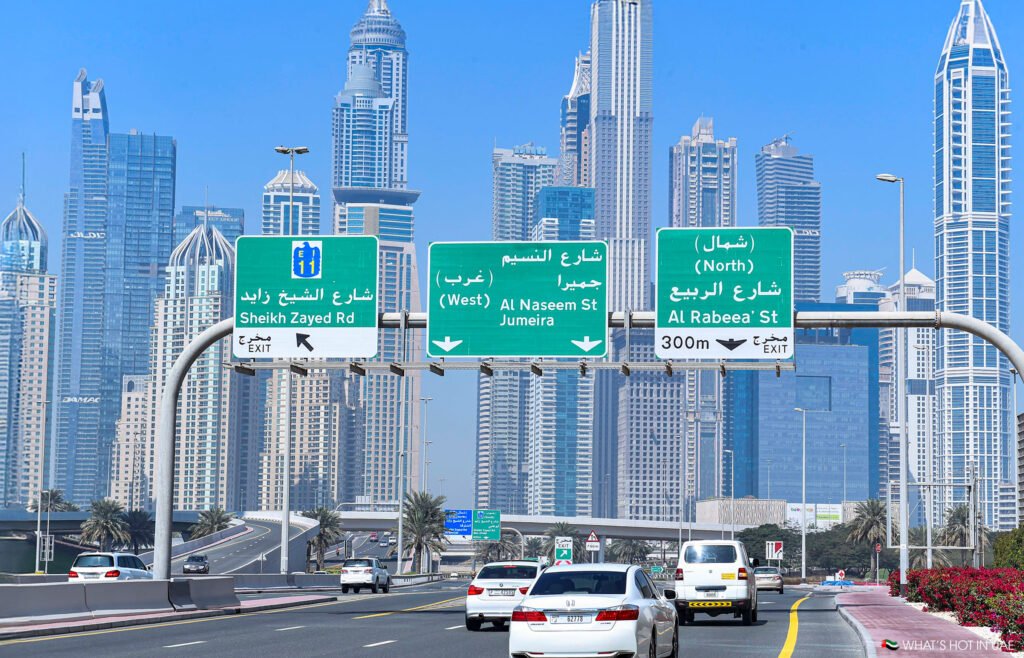The morning rush through Sheikh Zayed Road tells the complete story of Dubai traffic heating up. Millions of vehicles pulse through the city’s arteries daily, creating queues that stretch from Sharjah’s residential developments to Downtown’s gleaming towers. Your frustrating commute isn’t imagination – it’s statistical reality backed by overwhelming numbers.
The UAE registered nearly 390,000 new vehicles this past year alone. This surge pushed the national total above 4.56 million registered cars, with an estimated 3.5 million hitting Dubai’s roads every single day. That represents a staggering load for one metropolitan area, making Dubai the epicentre of the country’s escalating traffic crisis.
Understanding why Dubai traffic heating up affects everyone requires examining population growth, infrastructure strain, cultural patterns, and ambitious government solutions. The numbers reveal uncomfortable truths, but they also point toward innovative approaches that could transform daily commuting experiences across the Emirates.
The Shocking Numbers Behind Dubai’s Traffic Crisis
Statistical evidence confirms what every commuter suspects: Dubai traffic heating up represents more than temporary inconvenience. The data reveals systemic challenges that affect millions of residents daily.
UAE registered vehicles reached 4.56 million in 2024, representing a massive increase from previous years. Nearly 390,000 new vehicle registrations occurred within twelve months, creating unprecedented pressure on existing road infrastructure. These aren’t just statistics – they represent families, businesses, and individuals adding cars to already congested networks.
Dubai’s daily traffic load involves approximately 3.5 million vehicles navigating the city’s road system simultaneously. This concentration creates bottlenecks that affect everything from business productivity to family schedules. The sheer volume overwhelms infrastructure designed for smaller populations.
Population growth in Dubai alone added 208,000 residents during 2024. Each new household typically introduces one or two vehicles to the road network, compounding existing congestion problems. This growth rate shows no signs of slowing, suggesting traffic challenges will intensify without intervention.
Inter-emirate commuting adds another million vehicles daily as residents from Sharjah, Ajman, and Ras Al Khaimah travel to Dubai for work. This tidal wave of morning inbound traffic doubles journey times during peak hours, creating frustration that ripples throughout the regional economy.
Peak hour statistics reveal the true scale of Dubai traffic heating up. Morning rush periods from 7:00-9:00 AM see traffic volumes increase by 300% compared to off-peak times. Evening exodus from 5:00-7:00 PM creates similar congestion patterns that affect millions of commuters.
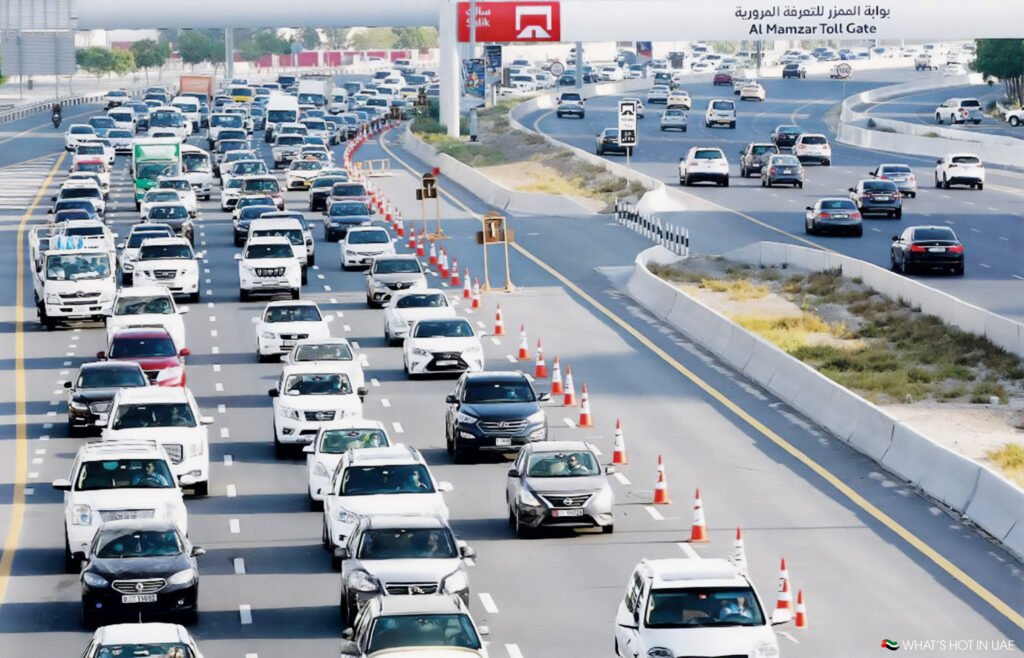
Real Stories: Human Impact of Traffic Chaos
Dubai traffic heating up affects real people with real consequences that extend far beyond minor inconvenience. Personal stories reveal how congestion shapes daily life across the Emirates.
A Sharjah-based banker living in Al Nahda describes his transformed commute experience. What once required 25 minutes during off-peak hours now stretches to 90 minutes by 7:30 AM. This time expansion forces earlier wake-ups, affects family breakfast routines, and creates stress that carries throughout working days.
Food delivery drivers face unique pressures as Dubai traffic heating up threatens their livelihoods. App-based timing requirements remain unchanged despite worsening congestion, forcing riders to weave dangerously between SUVs whilst risking late delivery penalties. Their safety and income depend on navigating increasingly congested roads efficiently.
Parents managing school runs experience seasonal traffic spikes that coincide with September reopenings. Families in Jumeirah Village Circle report that morning commute times double during school periods, particularly around congested areas like Hessa Street. These delays affect children’s punctuality and parents’ work schedules simultaneously.
Professional scheduling now revolves around traffic predictions rather than actual distances. Business lunches require traffic consideration, gym sessions wait for congestion to clear, and dinner reservations shift because crossing Downtown at 6:30 PM becomes impossible. Dubai traffic heating up dictates social and professional calendars.
Delivery and service industries struggle with timing guarantees that become unrealistic during peak congestion periods. Customer expectations remain high whilst traffic realities make prompt service increasingly difficult to maintain. This disconnect affects business reputations and customer satisfaction across multiple sectors.
Why Dubai Traffic Heating Up Accelerates Every Year
Multiple factors combine to create the perfect storm driving Dubai traffic heating up beyond manageable levels. Understanding these causes helps identify potential solutions and adaptation strategies.
Population explosion represents the primary driver behind increasing congestion. Dubai attracted over 208,000 new residents within twelve months, equivalent to adding an entire city the size of Ajman. Each household typically introduces multiple vehicles, creating exponential pressure on road networks designed for smaller populations.
Economic opportunity continues attracting professionals from across the region and internationally. Dubai’s status as a business hub means workers commute from neighbouring emirates daily, seeking career advancement whilst maintaining more affordable housing costs outside the city limits.
Inter-emirate commuting patterns create predictable traffic waves that overwhelm infrastructure during peak periods. Hundreds of thousands drive from Sharjah, Ajman, and Ras Al Khaimah into Dubai each morning, creating bottlenecks at emirate boundaries and major highway intersections.
Car-centric culture distinguishes Dubai from cities like London or Tokyo where public transport dominates commuting patterns. Despite Metro, tram, and bus infrastructure, private vehicle ownership remains the preferred transportation method. SUVs, luxury cars, and supercars crowd highways designed for mixed transportation approaches.
Seasonal patterns create predictable congestion spikes that compound baseline traffic problems. Ramadan brings unique rush periods before iftar, whilst Dubai Summer Surprises and major events create additional pressure around entertainment districts. Weekend congestion around Dubai Marina, JBR, and Downtown becomes almost impassable.
Construction and infrastructure development, whilst ultimately beneficial, creates temporary bottlenecks that affect traffic flow. Major projects require lane closures, diversions, and alternative routing that can persist for months or years during completion phases.
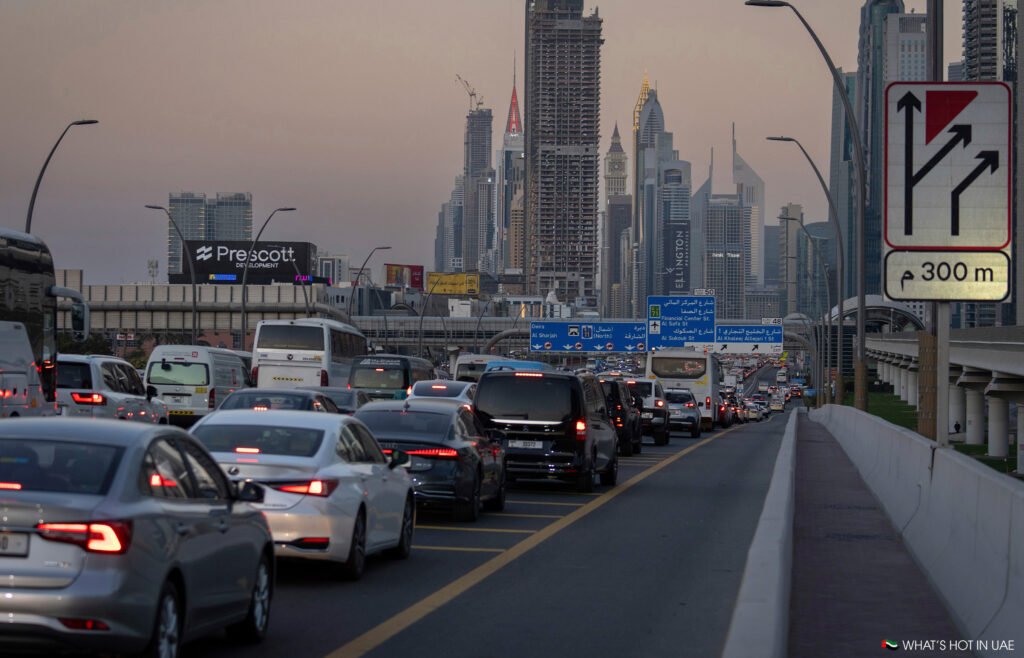
Government Response: RTA’s Battle Against Congestion
The Roads and Transport Authority recognises the scale of Dubai traffic heating up and implements comprehensive strategies to address systemic problems. Their multi-faceted approach combines infrastructure expansion with technological innovation and policy adjustments.
Thirty major infrastructure projects currently address the most congested corridors across Dubai. These developments target bottlenecks that create cascading delays throughout the transportation network. Al Khail Road expansion alone aims to accommodate an additional 10,000 vehicles per hour once completed.
Corridor improvements focus on eleven critical routes including Sheikh Mohammed Bin Zayed Road and Emirates Road. These upgrades involve lane additions, intersection redesigns, and traffic flow optimisation that should reduce journey times once construction completes. The scale represents billions of dirhams in transportation infrastructure investment.
Dynamic Salik pricing attempts to manage peak-hour demand through economic incentives. Variable toll rates encourage off-peak travel whilst generating revenue for further transportation improvements. This approach follows successful congestion pricing models implemented in London and Singapore.
Heavy vehicle restrictions during rush hours remove large trucks and commercial vehicles from peak-period traffic. These regulations reduce bottlenecks created by slower-moving vehicles whilst improving safety for passenger cars navigating congested areas.
Flexible work and school scheduling recommendations aim to distribute traffic across longer time periods. Government agencies promote remote work policies and staggered start times that reduce simultaneous commuting pressure. This behavioural approach complements infrastructure improvements.
Smart traffic management systems utilise artificial intelligence to optimise signal timing based on real-time traffic conditions. These technologies adapt to changing patterns throughout the day, reducing unnecessary delays at intersections and improving overall traffic flow efficiency.
Technology Solutions: Innovation Meets Infrastructure
Dubai’s approach to combating traffic heating up increasingly relies on technological solutions that optimise existing infrastructure whilst preparing for future transportation evolution. These innovations demonstrate the city’s commitment to smart urban development.
Salik digital tolling represents the foundation of intelligent traffic management. The system charges automatically whilst collecting data that informs traffic pattern analysis and policy decisions. Future expansions could include variable pricing that responds to real-time congestion levels.
Artificial intelligence drives traffic signal optimisation across the city’s intersection network. Smart systems monitor vehicle flow and adjust timing automatically, reducing unnecessary delays whilst improving overall traffic efficiency. These technologies learn from patterns and adapt to changing conditions throughout the day.
RTA mobile applications provide commuters with real-time information about Metro, tram, and bus schedules. Access to accurate timing data encourages public transport usage whilst helping drivers plan routes that avoid the most congested areas. Integration across transportation modes improves overall system efficiency.
Autonomous vehicle planning prepares Dubai for transportation revolution that could transform congestion patterns entirely. The city aims for 25% of trips to utilise driverless technology by 2030, potentially reducing private vehicle ownership whilst improving traffic flow through coordinated movement patterns.
Connected vehicle infrastructure enables cars to communicate with traffic systems and each other. This technology could optimise routing, reduce accidents, and improve traffic flow through coordinated decision-making that individual drivers cannot achieve independently.
Parking technology integration helps reduce congestion created by drivers searching for available spaces. Smart parking systems guide vehicles directly to open spots, reducing unnecessary circulation that contributes to traffic density in commercial and residential areas.
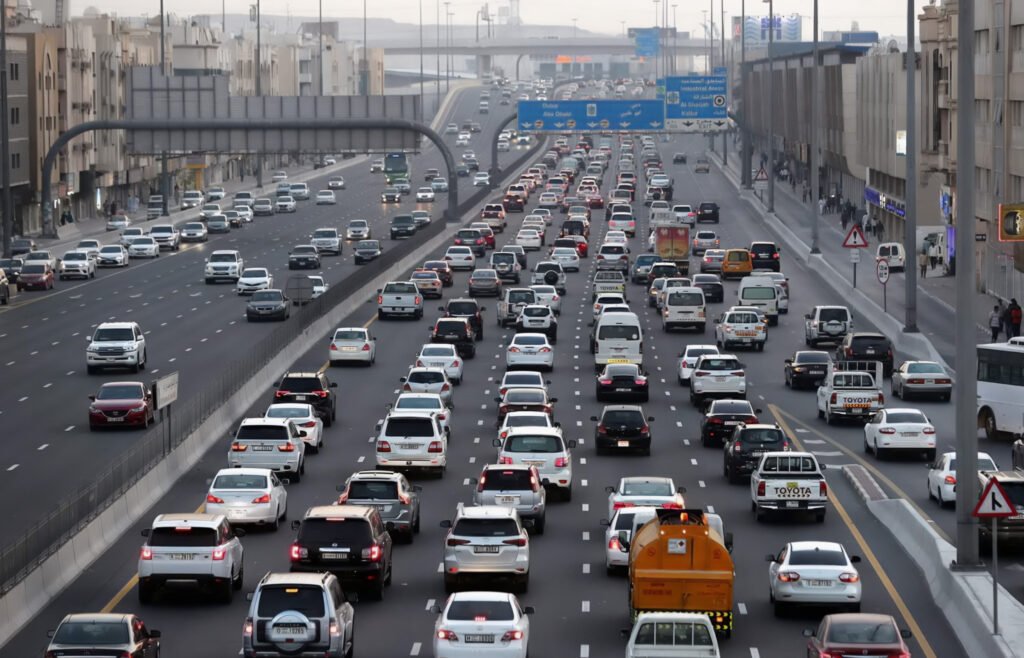
Cultural Factors Shaping Traffic Patterns
Dubai traffic heating up reflects unique cultural influences that distinguish Emirates traffic patterns from other international cities. Understanding these factors helps explain why standard solutions might require local adaptations.
Islamic cultural practices create predictable traffic surges that don’t exist in Western cities. Ramadan iftar rush generates massive traffic spikes as families race home before sunset. Friday prayer times shift midday traffic patterns around mosques throughout the city.
Ladies-only facilities including driving schools and gyms influence commuting patterns and timing preferences. These cultural accommodations create specific traffic flows that must be considered in infrastructure planning and traffic management strategies.
Long weekend travel patterns create outbound traffic jams toward destinations like Hatta, Ras Al Khaimah, and Abu Dhabi. These recreational traffic surges compound normal congestion whilst demonstrating the UAE’s strong internal tourism patterns.
Expatriate family structures often involve multiple vehicle ownership patterns that differ from single-car households common in other countries. Large families with multiple drivers create higher per-household vehicle density that multiplies infrastructure pressure.
Shopping and entertainment cultural preferences concentrate traffic around malls and leisure destinations during specific periods. Dubai’s climate drives indoor entertainment adoption, creating congestion patterns around major shopping centres that coincide with peak traffic times.
Business meeting culture still favours face-to-face interactions over video conferencing, maintaining high levels of business travel within the city. Professional networking expectations require physical presence at events, maintaining traffic levels that might decrease in more digitally-adapted business environments.
Policy Debates: Controversial Solutions Under Consideration
As Dubai traffic heating up reaches crisis levels, policymakers debate more aggressive intervention strategies that could dramatically alter transportation patterns. These discussions involve controversial measures that balance individual freedom with collective efficiency.
Vehicle registration caps represent one potential approach to controlling the total number of cars on Dubai roads. Such policies could limit new registrations whilst grandfathering existing vehicle owners, though implementation would face significant political and economic challenges.
Increased registration fees for multiple vehicle ownership could discourage households from maintaining several cars simultaneously. Progressive pricing structures might encourage families to reduce vehicle numbers whilst maintaining basic transportation access for essential needs.
Salik gate expansion could price access to the most congested corridors, following London’s congestion charge model. Additional toll points might discourage unnecessary trips whilst generating revenue for transportation improvements, though such measures often face public resistance.
Electric vehicle incentives could encourage fleet turnover whilst supporting environmental objectives. Reduced registration fees, free parking, and Salik exemptions for EVs might accelerate adoption whilst demonstrating government commitment to sustainable transportation.
Public transport subsidies could make Metro, tram, and bus options more attractive compared to private vehicle costs. Reduced fares or free access during peak hours might shift commuting patterns whilst supporting infrastructure utilisation improvements.
Carpooling incentives including HOV lanes and reduced tolls could encourage ride-sharing that reduces overall vehicle numbers during peak periods. Such policies require enforcement mechanisms and cultural shifts that support shared transportation approaches.
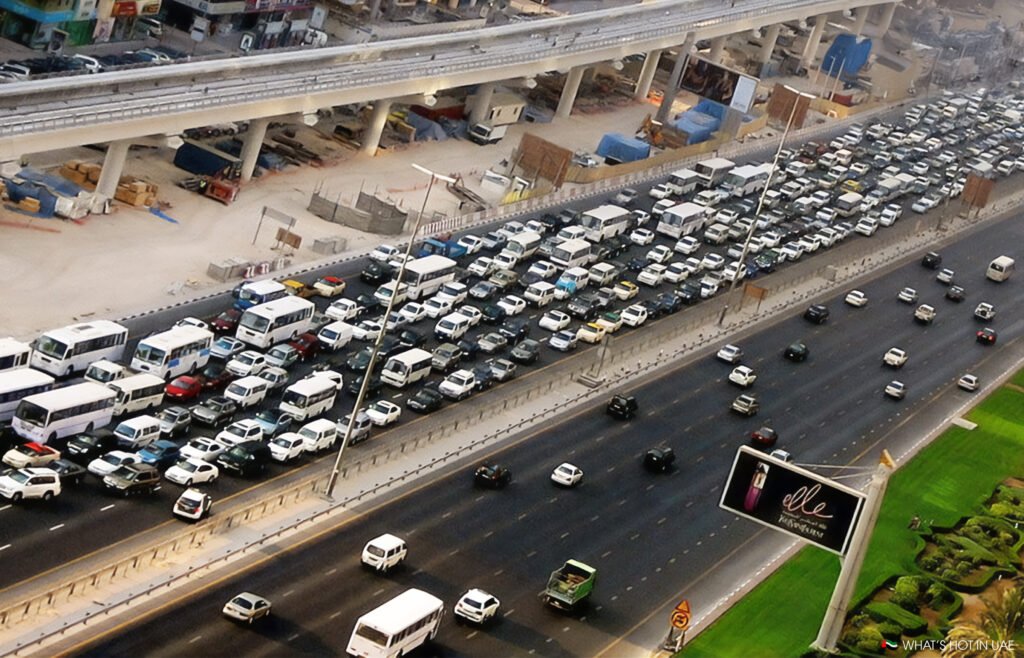
Economic Impact: When Traffic Costs Business
Dubai traffic heating up generates substantial economic costs that extend far beyond individual commuter frustration. Business productivity, delivery efficiency, and regional competitiveness all suffer when transportation systems fail to meet demand effectively.
Lost productivity from extended commuting times affects business operations across all sectors. Employees arriving late or stressed from traffic jams deliver reduced work quality whilst companies struggle with unpredictable staff availability during critical business hours.
Delivery and logistics costs increase dramatically when vehicles spend additional time in traffic rather than completing productive work. Food delivery, e-commerce fulfilment, and business services all face rising operational costs that ultimately affect consumer prices and business profitability.
Tourism experiences suffer when visitors encounter unexpected traffic delays that disrupt planned activities. International guests accustomed to efficient transportation systems may develop negative impressions that affect Dubai’s tourism reputation and repeat visitation rates.
Business meeting inefficiencies multiply when participants arrive late due to traffic unpredictability. Client relationships, deal negotiations, and professional collaborations suffer when transportation unreliability undermines business scheduling and commitment keeping.
Fuel consumption increases significantly when vehicles spend extended periods idling in traffic rather than moving efficiently between destinations. These costs affect household budgets whilst contributing to environmental problems that require additional government intervention.
Emergency service response times suffer when traffic congestion prevents rapid access to incident locations. Medical emergencies, fire responses, and police interventions all face delays that could have serious consequences for public safety and emergency management effectiveness.
Solutions in Progress: Hope on the Horizon
Despite Dubai traffic heating up creating immediate challenges, multiple solution pathways offer hope for improved conditions. Infrastructure improvements, technological advances, and policy innovations work together toward more manageable transportation systems.
Major construction projects currently underway will dramatically increase road capacity once completed. Al Khail Road expansion, E311 improvements, and Ras Al Khor corridor development represent billions of dirhams in transportation infrastructure investment that should reduce congestion significantly.
Metro expansion plans extend rail service to additional areas of Dubai, potentially reducing private vehicle dependence for thousands of daily commuters. New stations and routes provide alternatives that could shift transportation patterns away from overcrowded highways.
Flexible work arrangements adopted during the pandemic continue reducing peak-hour traffic pressure as companies maintain remote and hybrid work policies. These behavioural changes distribute commuting across longer time periods, reducing simultaneous traffic loads.
Smart city technologies improve traffic flow through intelligent systems that respond to real-time conditions. Adaptive traffic signals, connected vehicle infrastructure, and integrated transportation management create efficiency gains from existing road capacity.
Public transport improvements including increased frequency, expanded coverage, and enhanced comfort levels make alternatives to private vehicle ownership more attractive. Investment in bus rapid transit, improved Metro facilities, and integrated payment systems support modal shift objectives.
Electric vehicle adoption reduces local emissions whilst preparing infrastructure for future transportation evolution. Charging networks, government incentives, and vehicle availability improvements demonstrate progress toward more sustainable transportation systems.



